
CodeNotes: Solar Water Heating Systems
CodeNotes provides a description of the most common solar water heating systems used for residential and small commercial applications.
This edition of CodeNotes — Solar Water Heating Systems — is based on the 2021 International Solar Energy Provisions™.
Introduction
Solar water heating systems provide an efficient way to meet hot water loads in most climates. Unlike photovoltaic (PV) systems that generate electricity, most solar water heating systems directly heat fluids using solar energy. Fluid flows through outdoor solar thermal collectors where it is warmed by the sun.
Solar energy has been used to heat water for centuries. Modern solar water heaters first appeared in the late 1800s and have been refined considerably since. Designs range from a simple “tank in a box” configuration to complex arrangements with multiple collectors, tanks, sensors and advanced controls.
Domestic water heating systems are encountered most frequently by code officials. Residential domestic systems typically make use of one to four solar collectors mounted on the roof. These are tied to one or two storage tanks (50 to 120 gallons), through insulated piping. For active systems, a pump controlled by a differential controller moves water from the tank to the collector for heating. Passive systems rely on natural convection to move the water and typically have the storage tank on the roof above or within the collectors. Depending on the local climate, systems may also include a heat exchanger, mounted either inside or outside of the tank. A fluid with a lower freezing point, like glycol, is then circulated between the collector and heat exchanger.
A properly sized solar water heating system is typically designed to provide approximately 80–90 percent of the required hot water load. This is to prevent overheating of the systems on peak solar days. As such, all solar water heating systems require a backup system. Common forms of backup are electric or gas water heaters, tankless water heaters, or indirect tanks heated by a boiler.
Common sizes for thermal collectors used in these systems are 4′ x 8′ or 4′ x 10′. Unlike PV modules, they usually only cover a portion of the roof.
This CodeNotes™ provides a description of the most common solar water heating systems used for residential and small commercial applications along with suggestions for inspecting them in accordance with the requirements found in 2021 I-Codes®. It will cover:
- System design types
- Solar collector installation
- Storage tank and heat exchanger issues
- Piping system inspection
Code provisions for solar water heating systems are centered in Chapter 23 of the 2021 International Residential Code® (IRC®) for residential systems and Chapter 14 of the 2021 International Mechanical Code® (IMC®) for commercial systems. The 2021 International Building Code® (IBC®) also briefly addresses solar water heaters, in Section 3111. These chapters then reference other provisions elsewhere in the IRC, IBC, International Plumbing Code® (IPC®), International Fire Code® (IFC®) and International Energy Conservation Code® (IECC®). The IRC, IMC and IBC reference and require compliance with the ICC 901/SRCC 100 Solar Thermal Collector Standard and ICC 900/SRCC 300 Solar Thermal System Standard that provide other significant details. Certification is available from certification bodies like the Solar Rating and Certification Corporation (ICC-SRCC) to demonstrate compliance with these standards.
For ease of access to these widespread provisions, ICC published the International Solar Energy Provisions™ (ISEP™). The ISEP contains a complete listing of all provisions for solar thermal and photovoltaic systems within the full family of 2021 I-Codes, the 2020 National Electrical Code® (NEC®) from NFPA and the standards ICC 901/SRCC 100 and ICC 900/SRCC 300.

Solar Water Heating System Designs
There are two basic types of solar thermal water heating systems:
- Active: a pump circulates fluid being heated through the collectors
- Passive: natural convection (gravity and density) and city water pressure produce flow through the collectors
Each of these types can be divided into two configurations:
- Direct: Potable water circulates between the tank and collectors and is heated directly by the sun.
- Indirect: A secondary fluid like water or antifreeze flows between the tank and collectors where it is heated by the sun. The heat in the fluid is transferred to potable water through a heat exchanger (Figure 1).
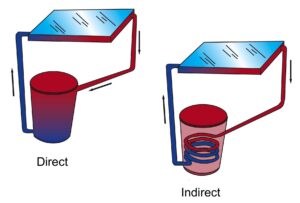
The configuration chosen for each installation depends in large part on the potential for freezing. Every system must account for freezing and overheating protection. Proper sizing is the first line of defense, with chemical solutions, and mechanical devices, secondary.
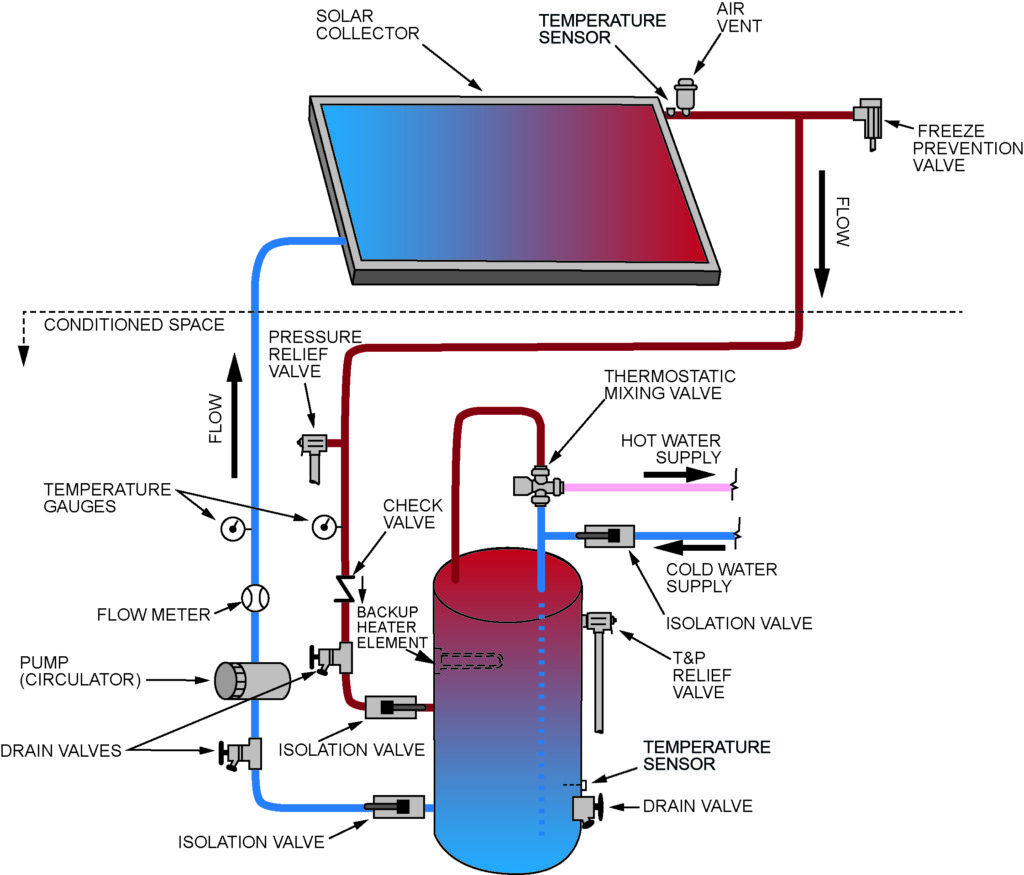
It is important for code officials to first determine the type and then configuration of system in order to determine which code provisions are applicable and what to inspect. The single tank, active, direct system shown in Figure 2 is common only in warm climates, such as Florida, where the potential for freezing weather is minimal. In this system, a device called a freeze prevention valve prevents freezing during occasional, short events where the temperature dips below freezing. Freeze prevention valves release a small amount of water onto the roof at a preset temperature to permit warmer water from the storage tank into the outdoor piping and collector. Single tank systems, like the system shown, incorporate a backup electrical heating element to supplement the heat provided by the solar system when needed.
The double tank, active, indirect system shown in Figure 3 is common in areas where the air temperature falls below freezing for extended periods of time. Here, the collector is isolated from the domestic supply piping and is connected to separate piping known as the solar loop. A pump circulates the fluid in the solar loop as needed. Potable water is not supplied to the collector where it could be subject to freezing conditions. Instead heat from the solar loop is exchanged with potable water through an immersed heat exchanger coil in the solar tank. In this system, a tank-type water heater is used as the backup heat source that functions only when needed. Alternatively, a tankless water heater can provide the necessary backup if they are rated to accept pre-heated water.
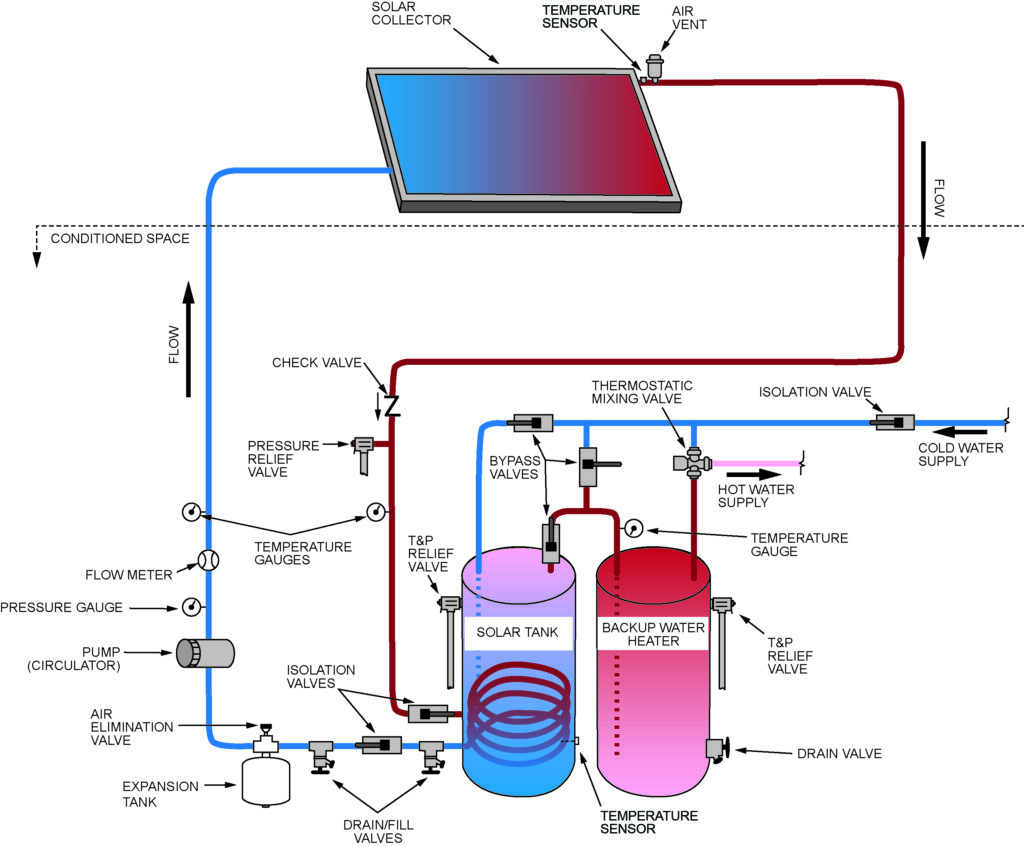
Key Inspection Points
Solar thermal systems touch many building parts and systems, including roofing, structural, plumbing, mechanical and electrical. They also involve unique components, elevation and outdoor exposures that make their inspection a challenge. This section lists some specific considerations when inspecting solar thermal water heaters. It is not exhaustive and users should consult the 2018 ISEP for all relevant codes and standards.
Collector Location and Orientation
Solar thermal collectors are usually mounted on the roof of a building (Figure 4) but can be mounted on a rack situated at ground level. While the code does not specify it, most systems are installed facing due south, at an angle a little less than the latitude of the site, to achieve the highest performance throughout the day and year. Systems can be situated facing due east or due west, but should never face north. The location should also take into account the potential for shading of collectors that can take place. Shading from trees is the most common, and can also come from rooftop features like parapets and chimneys, neighboring buildings, or geographic features.
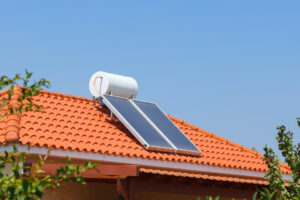
Listing and Labeling
The IBC, IRC, IMC and International Swimming Pool and Spa Code® (ISPSC®) require solar thermal collectors to be listed and labeled to relevant sections of ICC 901/SRCC 100 (See IBC 3111.2, IRC M2301.3, IMC 1401.4.1, ISPSC 316.6.2). Certified collectors are commonly marked as shown in Figure 5. Certified collectors undergo rigorous testing to ensure their safety and durability and measure their energy production ratings. These ratings are often provided on the certification labels and are used by many local programs to set rebates and incentives for the building owner.
The IBC, IRC, IPC and IMC also require that the entire solar thermal system be listed and labeled to ICC 900/SRCC 300 (See IBC 3111.2, IRC M2005.1, IPC 502.1 and IMC 1401.4.1). This standard sets the requirements for all components in the system and the overall function of the system. It too requires that solar thermal collectors comply with ICC 901/SRCC 100.
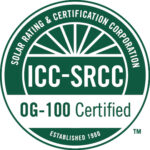
Solar water heating systems certified by the Solar Rating & Certification Corporation (ICCC-SRCC) will have a page in the owner’s manual, and a label on the collector, listing the ICC-SRCC certification numbers for each certified system model. This certification assures that the system design and manuals have been reviewed by ICC-SRCC. The ICC-SRCC website, www.solar rating.org, provides a directory of collectors and systems with current certifications and information on their configuration and performance. With this assurance, the primary purpose of inspection is to verify that compliant systems have been installed in accordance with the certified design and manufacturer’s requirements and meet all local code requirements.
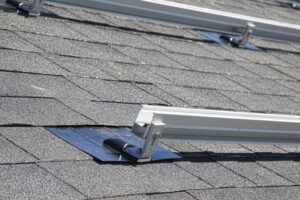
Structural Mounting of Collectors
Collectors must be installed on a mount capable of maintaining the orientation to design conditions and must be constructed of proper materials and approved for outdoor use. Structural mounts must be able to withstand wind, seismic and snow loads. Connection points to the roof must be flashed and sealed (Figure 6) to prevent the entry of water, rodents and insects (See IRC M2301.2.9, IMC 1402.7.2). The roof structure must be capable of supporting all loads imposed by solar thermal systems that may vary significantly by type (See IBC 3111.1, IRC M2301.2.2.1, IMC 1402.8.1.2).
Supports and brackets, the base of which are lag bolted to rafters, or blocking between rafters, is the method most frequently used to attach solar collectors to the roof. With open rafters, a spanner mount (Figure 7) is occasionally used. The manufacturer’s mounting installation requirements should be followed for the specific collector and roofing type.
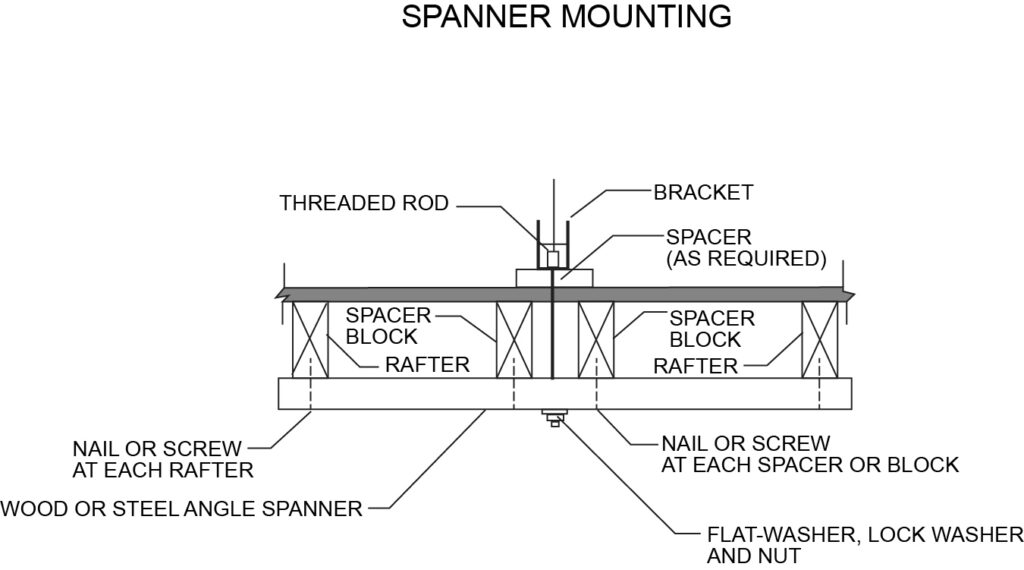
Dissimilar metals that have galvanic action shall be isolated.
Penetrations
Penetrations of the building, through which piping or wiring is passed, shall not reduce nor impair the function of the enclosure, reduce any fire-resistance rating, nor allow intrusion by water, insects and/or vermin, in accordance with the plumbing code and mechanical code adopted by the authority having jurisdiction, or in the absence of such code, the latest version of the IRC and IMC (See IRC M2301.2.9, IMC 1402.7.2). Figure 8 shows a “gooseneck” flashing that is commonly used for solar thermal installations to seal both piping and electrical penetrations.
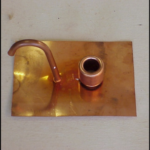
Access
The location of solar components must not impair the accessibility needed to maintain the building or site. Roof access, pathways, and spacing requirements shall be provided (See IBC 3111.3.4, IRC M2301.2.1, IMC 1402.2).
Storage Tanks and Auxiliary Water Heaters
Storage tanks and auxiliary heating equipment for solar water heating systems are typically installed in a garage or an equipment room situated to minimize the piping run to the solar collector array. There can be one (Figure 2) or two (Figure 3) tanks in the system. In the two-tank design, one tank stores solar-heated water and the other tank contains the auxiliary heater. Some systems may also contain a small drain-back tank (Figures 9, 10) that holds the fluid from the solar loop when the pump is turned off. This system design uses water as the system fluid, but allows it to drain by gravity into conditioned space to prevent it from freezing when the pump is not operating. The drain-back system provides the best protection for both freezing and over-heating.
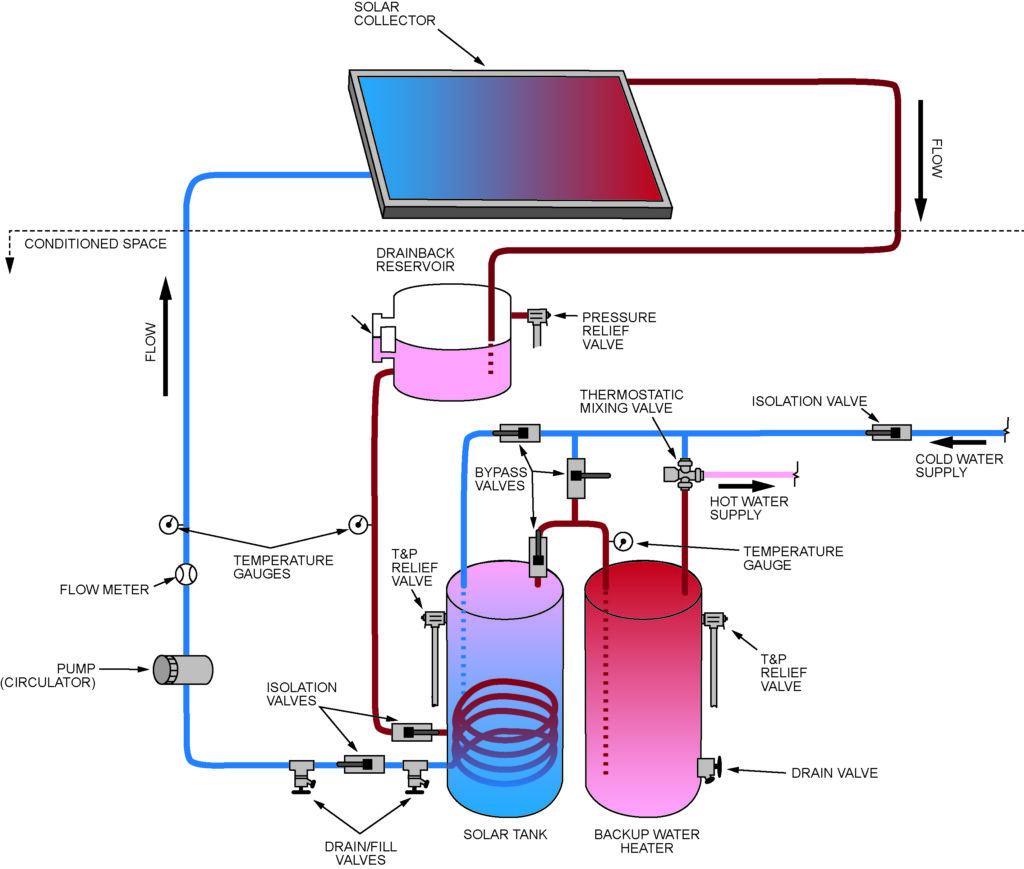
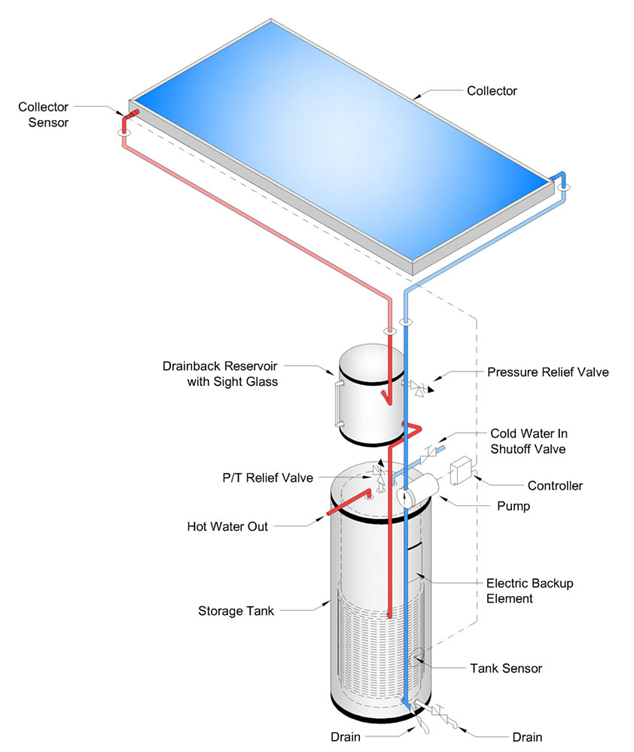
ICC 900/SRCC 300 requires that storage tanks be insulated to an R-value of not less than R-12.5 (h ft2 °F)/Btu, (R-2.2 m2 K/W). When installed outdoors they must be specifically designed for and rated for outdoor installation. The standard allows for the use of non-pressurized tanks but requires them to be vented (301.4.1.5).
Auxiliary heating equipment must be listed and labeled by a recognized third-party listing agency and installed in accordance with the code requirements applicable to the type of fuel used.
Heat Exchangers and Heat Transfer Fluids
Indirect systems make use of a heat exchanger to transfer heat from the solar loop to the potable water without contact or mixing between the two fluids. The type of fluid used in the collector loop determines the minimum heat exchanger requirements. When the heat transfer fluid is not food grade, or the maximum operating pressure of the solar loop is greater than the normal operating pressure of the potable water system, a double-walled heat exchanger must be used. Double-walled heat exchangers have two walls with a space between that is vented to the atmosphere and discharges to a visible location (Figure 11). Single-wall heat exchangers may only be used with food-grade heat transfer fluids and/or potable water in the solar loop. Every heat exchanger must be labeled to indicate its type (See IMC Section 1402.8.4, 1404.4, IRC M2301.7.1).
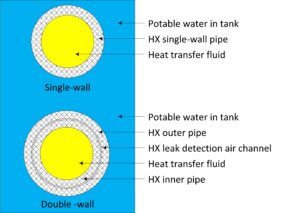
Pipe Insulation
The exterior of the piping shall be insulated and properly supported and protected from corrosion and degradation. Exterior piping insulation shall be rated for outdoor use and protected from ultraviolet radiation and moisture damage (See IMC 1402.8.3, IRC M2301.2.5).
Safety Devices
Solar water heaters, like other hot water heaters, are provided with several devices to ensure the safe operation of the systems. Solar energy system components containing pressurized fluids must be protected against excessive pressures and temperatures. Safety devices and safety relief valves must be listed and labeled, and must have a minimum rated capacity for the equipment or appliances served. Each section of the system in which excessive pressures are capable of developing cannot be isolated from a relief device. For indirect systems, this means that a pressure relief valve may be needed on the solar loop in addition to the valve on a solar tank or auxiliary water heater.
Relief valve installation, and discharge, must conform to the plumbing code adopted by the authority having jurisdiction in the same way as other types of water heaters. Safety and relief valve discharge pipes must be of rigid pipe, of the same diameter as the safety or relief valve outlet, approved for the temperature of the system, and must not discharge so as to be a nuisance, hazard, nor cause damage (IRC, P2804, IPC 504.6). Note that where the heat transfer fluid is not water or food-grade fluid, it may be necessary to contain the discharge instead of disposing of it to the sanitary sewer. In that case, follow the manufacturer’s recommendations and local requirements for the disposal of the fluid.
Solar water heaters can develop very high-temperature water, so high-temperature protections are needed for many system types. ICC 900/SRCC 300 requires that thermostatic mixing valves complying with ASSE 1017 be used where the system supplies water to a potable hot water system. ICC 901/SRCC 100 requires that collectors be able to withstand what is known as the stagnation temperature – the worst-case condition where there is no fluid flow and temperatures build up to their highest levels. Additionally, the IRC limits the maximum temperature in Section M2301.2.12 to 180°F (82°C) inside the dwelling. The IMC contains no such limitation but does require an ASSE 1017 valve where systems supply water and space heating systems over 140ºF (60ºC) (See 1002.2.2).
To accommodate the heating and cooling of the fluid in the solar loop, an expansion tank is required in all system designs except drain-back to absorb thermal expansion in the fluid (See IMC 1402.8.7, IRC M2301.2.8). In drain-back systems, the drain-back tank is designed to absorb the variations in fluid volume in the solar loop.
Where systems are directly connected to the potable water supply, they are required to incorporate backflow protection to protect the public water supply (See IRC M2301.5 and IMC 1402.5.3).
Piping
ICC 900/SRCC 300 Section 301.9.2 requires that hot water distribution pipe and tubing have a pressure rating of not less than 100 psi (690 kPa) at 180ºF (82ºC) and meet performance standards for the specific type of pipe per the IMC and IRC. Potable water piping must comply with NSF 61 and 372 and contain a weighted average lead content of 0.25% or less (See IPC 605.2.1, IRC P2906.2.1).
Pipe hangers must support the weight of the filled pipe, must not cause galvanic corrosion and shall not compress or damage the insulation material. For drain-back systems, it is very important that pipes between the collector and drain-back tank be mounted to preserve the required slope along their length (See IMC 1402.4.1, IRC M2301.2.6.1). Drainback piping should not be permitted to sag where ponding and pooling of the fluid can occur.
Service Connections
Connections must be provided with shut-off valves and caps for filling, draining and flushing liquid systems. These must be labeled with the contents to prevent the accidental introduction of improper (toxic) fluids and to protect operators from spraying hot or highly pressurized fluids (See IMC 1402.8.6.2, IRC M2301.2.11.2).
Isolation Valves
The piping system shall be provided with isolation valves to prevent flow to the solar loop and solar thermal collectors when they are inoperative or being serviced (See IMC 1402.8.6, IPC M2301.2.11). ICC 900/SRCC 300 Section 301.9.10 also requires the installation of valves to bypass the solar thermal system and allow the continued operation of the auxiliary water heater.
Pumps and Controls
In many systems, pumps, valves and controls are packaged, with many of the other system components in an integrated assembly known as a pump station.
Active systems can contain one or two pumps. Passive systems use no pumps, relying instead on natural convection to circulate the fluid. The pump(s) in an active system are low-head circulators that are typically turned on and off by a differential controller. The controller compares the temperature of the fluid in the tank and collector using temperature sensors mounted at the collector array outlet and near the bottom of the solar storage tank (Figures 2 and 3). When the difference between the temperatures at these two points rises to a pre-determined level, the pump activates and moves heated water from the collector to the tank.
These sensors should be well insulated and thus are typically not visible during inspection. The wiring to and from the sensors is typically low voltage but should be installed in accordance with the NEC and protected from the environment.
Proper System Operation
All systems are required to include a means of determining whether the system is operating properly. This is usually accomplished with temperature gauges, flow meters, sight glasses and/or indicator lights on the electronic controllers. See the system operating manual for readings to expect on these devices.
In general, when the sun is shining, the flow meter should indicate flow and the temperature of the fluid returning from the solar collector should be warmer than the fluid going to the collector. In a two-tank system, the temperature leaving the solar storage tank should be warmer than the city’s mains temperature when hot water is being drawn from the system.
To learn more and access additional resources, please visit the Code Council’s PMG website.








